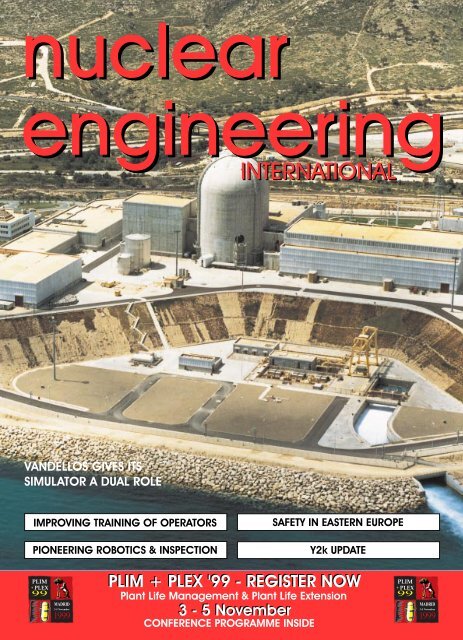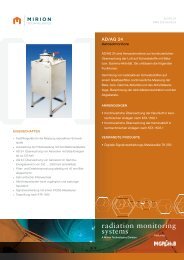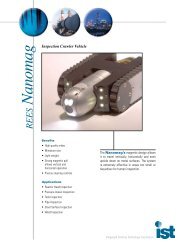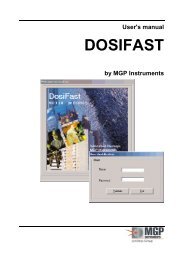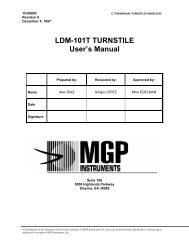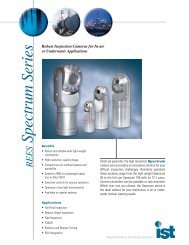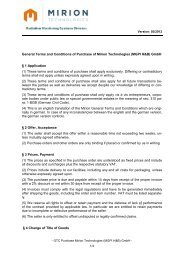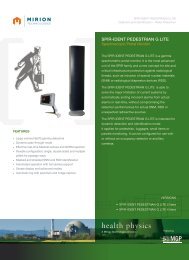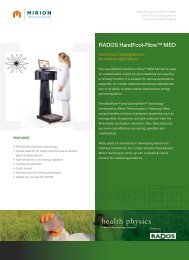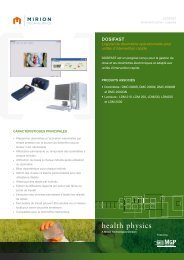The new "thru-wall" look at Sellafield - Mirion Technologies
The new "thru-wall" look at Sellafield - Mirion Technologies
The new "thru-wall" look at Sellafield - Mirion Technologies
Create successful ePaper yourself
Turn your PDF publications into a flip-book with our unique Google optimized e-Paper software.
nuclear<br />
engineering<br />
VANDELLOS GIVES ITS<br />
SIMULATOR A DUAL ROLE<br />
IMPROVING TRAINING OF OPERATORS<br />
PLIM<br />
+ PLEX<br />
99<br />
MADRID<br />
3-5 November<br />
1999<br />
PLIM + PLEX '99 - REGISTER NOW<br />
Plant Life Management & Plant Life Extension<br />
3 - 5 November<br />
CONFERENCE PROGRAMME INSIDE<br />
INTERNATIONAL<br />
SAFETY IN EASTERN EUROPE<br />
PIONEERING ROBOTICS & INSPECTION Y2k UPDATE<br />
PLIM<br />
+ PLEX<br />
99<br />
MADRID<br />
3-5 November<br />
1999
INSPECTION & ROBOTICS ROUND-UP<br />
<strong>The</strong> <strong>new</strong> "<strong>thru</strong>-wall" <strong>look</strong> <strong>at</strong> <strong>Sellafield</strong><br />
BNFL and IST-rees have been<br />
working together to develop high<br />
performance optical inspection systems<br />
for viewing through shield walls of active cells<br />
for many years. <strong>The</strong> l<strong>at</strong>est version, a "<strong>thru</strong>-wall"<br />
(and roof) endoscope camera system, will be fitted<br />
into the <strong>Sellafield</strong> Drypack Plant (SDP). <strong>The</strong><br />
system optically relays a view of the inside of a<br />
cell to a ccd cameral on the cold side of the wall,<br />
elimin<strong>at</strong>ing the cumbersome process of withdrawing<br />
the camera assembly and its associ<strong>at</strong>ed<br />
shield plug from the wall for maintenance. This<br />
significantly reduces maintenance costs and staff<br />
dose uptake. <strong>The</strong> system offers standard and wide<br />
angle fields of view with 6:1 zoom range.<br />
<strong>The</strong> endoscope provides shielding against the<br />
radi<strong>at</strong>ion shine p<strong>at</strong>h by placing fused silica blocks<br />
in the viewing p<strong>at</strong>h allowing standard ccd cameras<br />
to be used r<strong>at</strong>her than radi<strong>at</strong>ion tolerant cameras.<br />
This enables the system to be simply upgraded<br />
as ccd technology advances.<br />
<strong>The</strong> design of the <strong>new</strong> modular endoscope<br />
system benefited from the experience of the first<br />
two endoscope projects <strong>at</strong> <strong>Sellafield</strong>, for the vitrific<strong>at</strong>ion<br />
plant (VIT Line 3) and the Silo Emptying<br />
Plant (SEP). <strong>The</strong> first used the first modular<br />
design to gener<strong>at</strong>e through-wall endoscope<br />
systems for wall thickness of 1000 mm and 1550<br />
mm incorpor<strong>at</strong>ing double prism technology in a<br />
viewing head for image correction. <strong>The</strong> SEP<br />
project called for developing a wider angle of<br />
view and through-roof variant using the same<br />
endoscope assembly. This required the second<br />
image correcting prism to be loc<strong>at</strong>ed within the<br />
endoscope and not part of the viewing head.<br />
<strong>The</strong> l<strong>at</strong>est modular version was inspired by<br />
SDP which has a number of different wall thicknesses<br />
and through roof variants. It combines the<br />
technologies developed on VIT 3 and SEP.<br />
<strong>The</strong> system provides an oper<strong>at</strong>or with full<br />
hemisphere viewing through a single non-browning<br />
glass viewing dome loc<strong>at</strong>ed inside the cell,<br />
taking up very little space and providing a biological<br />
shield. This is achieved using a rot<strong>at</strong>ing<br />
and tilting prism loc<strong>at</strong>ed in a viewing assembly,<br />
32<br />
Non-browning<br />
Glass Dome<br />
Silo Emptying Plant (SEP) Endoscope on a transport trolley<br />
Thru-wall endoscope<br />
Optical Head Filler Liner Alpha Liner Endoscope<br />
Diagram of the IST-Rees '<strong>thru</strong>-wall' endoscope<br />
tested for 30 year oper<strong>at</strong>ion, <strong>at</strong> the front of the<br />
system. This prism is driven from control electronics<br />
on the cold side via drive shafts.<br />
<strong>The</strong> endoscope is loc<strong>at</strong>ed behind this front<br />
prism in order to relay the image to a ccd camera<br />
on the cold side. This endoscope contains a<br />
second rot<strong>at</strong>ing prism for image correction which<br />
is driven off the same rot<strong>at</strong>e drive shaft as the<br />
front prism. <strong>The</strong> difference between through wall<br />
and roof systems is simply the rot<strong>at</strong>ional speed<br />
rel<strong>at</strong>ionship between the two prisms, which can<br />
be changed via a gearbox.<br />
At the rear of the system, on cold side, is an<br />
electronics enclosure containing the ccd camera,<br />
telemetry receiver card and all the drive electronics.<br />
In the case of a through wall system, an<br />
addition control card is fitted, developed by<br />
BNFL Product development Centre <strong>at</strong><br />
Capenhurst, which enables the system to emul<strong>at</strong>e<br />
a standard pan<br />
and tilt system.<br />
This important fe<strong>at</strong>ure<br />
ensures th<strong>at</strong><br />
the system can be<br />
controlled intuitively<br />
by the oper<strong>at</strong>or<br />
making the<br />
system user<br />
friendly and reducing<br />
training times.<br />
<strong>The</strong> endoscopes<br />
are made up<br />
of a combin<strong>at</strong>ion of<br />
standard modules,<br />
which enable the<br />
Electronics<br />
Enclosure<br />
system to c<strong>at</strong>er for wall/roof thicknesses from<br />
750 mm to 2000 mm in steps of 250 mm. <strong>The</strong>re<br />
is a choice of front module between wide and<br />
standard fields of view.<br />
<strong>The</strong> viewing head, endoscope, drive shafts<br />
and electronics enclosure form one assembly<br />
which is fitted into an Alpha liner (on which is<br />
mounted the non-browning glass dome). This<br />
enables the oper<strong>at</strong>ional parts of the system to be<br />
removed, without breaking biological containment,<br />
should any maintenance be required. <strong>The</strong><br />
whole system will fit into a minimum of 150 mm<br />
encast liner, thus removing the civil engineering<br />
issues associ<strong>at</strong>ed with larger encast liners. Large<br />
encast liners can be c<strong>at</strong>ered for using filler liners<br />
within the system.<br />
Nuclear Engineering Intern<strong>at</strong>ional<br />
n


